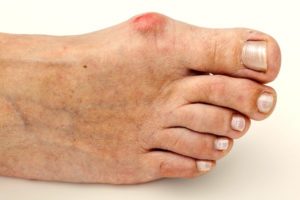Medically known as Hallux Abducto Valgus (HAV), the term ‘bunion’ describes a bony bulge that can develop over time on the inside of the big toe. The bulge is caused by a malaligned position of the big toe joint where the long bone (metatarsal) moves out towards the other foot and the connecting toe (phalanx) bends in on it, toward the other toes. Bunions tend to progressively worsen in ‘stages’ and become more prominent. As they do, the ligaments and tissues surrounding the joint stretch and contract accordingly, ultimately leaving the joint in a fixed position. Bony and arthritic changes can also occur within the joint. This means that bunions have different characteristics at different stages and the right management needs to be decided on a case-by-case basis.
Causes of bunions are numerous and vary greatly. Anything that squeezes or puts greater pressure and force through the big toe joint, like pointed shoes, may be a potential contributing factor. Often bunions can run in the family, are more prevalent in women than men, and are thought to be linked with an unstable function at the big toe joint. Other contributing factors include:

The biggest sign is the change in appearance (protrusion) of the big toe joint. You may also experience:
As the bunion progressively worsens, the big toe may push into the lesser toes. Over time, the toes may begin to overlap.
As bunions progressively worsen over time, starting treatment early is the key! If you’ve started noticing your bunion developing either recently or within the last couple of years, now is the best time to take action.We start by identifying the extent of the changes in the big toe joint. A treatment plan can then be implemented to reduce symptoms and limit future progression. Biomechanical and alignment issues will be identified. Periodic evaluation and x-rays may be advised or in some cases observation of the bunion is sufficient. Depending on the characteristics of your bunion, you may benefit from some of the following:
As bunions are often associated with other foot problems, treatment will also address any underlying issues that are identified. If the symptoms or the deformation is not reducible, surgery may be indicated.
.png)
Since introducing shockwave therapy, we’ve helped many of our patients avoid surgery for certain conditions. Here's what you
need to know about shockwave treatment and how it works.
.png)
This Mother’s Day, consider a practical, medically safe, and confidence-boosting gift: a professional KeryFlex nail restoration treatment. It’s a simple, effective, and medically safe way to instantly transform the appearance of toenails.

In some cases like arthritis, continuing to stay active is one of the best things you can do for your joints. Is the same true if you're in pain or have an injury?

A stroke is New Zealand's second single biggest cause of death and a leading cause of serious adult disability. Here's how podiatry can help in your rehabilitation.
Keeping your family on their feet and helping them to walk, run, play and exceed their goals is why we love getting up in the morning.
Ground Floor, One Health Building
122 Remuera Rd, Remuera
Auckland 1050, New Zealand
| MON - FRI | 7:30am – 6:30pm |
| SAT | 8:30am – 4:30pm |
| SUN | Some availability |
Make an Appointment
Online Schedule